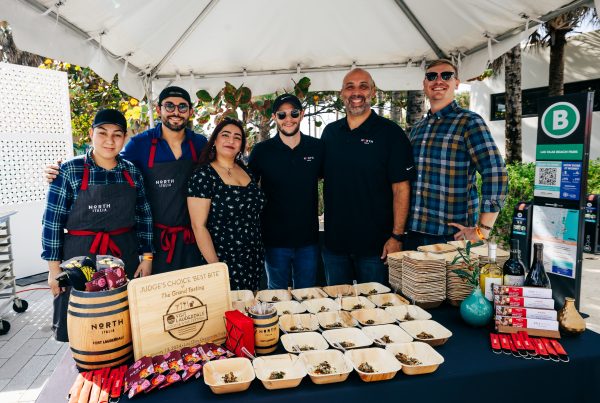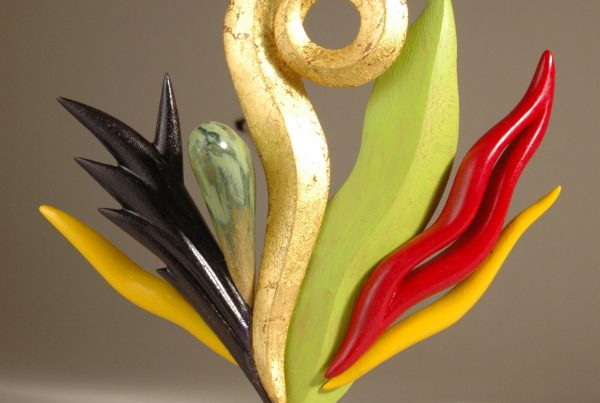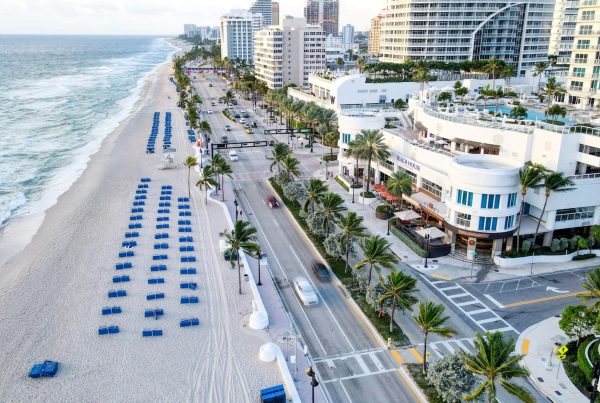In the multimedia artworks of Ron Garrett, marine life is often comprised of the very materials that led to its downfall. Such was the case with “Manatee’s Lament,” a highlight of the Cornell Art Museum’s “World of Water” exhibition earlier this year.
Created to scale, the ceiling-mounted resin sculpture is covered entirely from the up-cycled debris that has crept into the manatee’s polluted home, serving as a reminder of humans’ impact on the beloved sea cow. Similarly, Garrett’s sculpture “Fate” offers a hammerhead shark, its body dragging a motley assemblage of deadly detritus—a tire, a giant hook, bubble wrap, netting, rope, Styrofoam, plastic bottles, a broken surfboard.
As Garrett reveals to Boca magazine, he grew up around the ocean, and its impact has reverberated across the decades. A Boca Raton resident and a graduate of Ringling College of Art and
Design, Garrett has enjoyed a 30-year career in the visual arts. He is also an accomplished printmaker, running his own RAGA Press. When not working on his art, he enjoys refurbishing vintage printing presses the way a gearhead likes tinkering with old cars. Four such machines fill the living room of his atelier, including one formerly rusty hulk, dredged from a seabed, that dates to the 1880s. With its manual wheel to turn the levers, “it would be something Rembrandt and Goya would feel absolutely at home on,” Garrett says.
Why is the connection to the ocean so strong in your work?
The early connection goes back to childhood. Until I was 13, I lived right off the beach in Juno Beach. At the time—this is going to be hard to imagine—there was nothing there. All along the Intracoastal, there were no houses. It was just woods. We were underneath the tall, Australian pines playing all the time. We’d literally be in the water, and pods of manatee would come along and swim right beside us. I’d see that big tail go by. That made a very strong connection.
Then when we moved to North Carolina … it created a longing for that lost paradise. … I always missed the more subtropical coastal waterworld of Florida.
When did your work begin to take on an environmental awareness?
I think it was always there. It would come and go. When I was working on my BFA, I was doing figurative heads. But the heads always had strong landscape or nature components going on within them. So it wasn’t just the head; it was a head made of roots, or it was a head coming right out of the ground: The buried past, the passage of time, all the metaphorical or allegorical things tended to work their way into it.
Tell me about making your sculpture “Manatee’s Lament.”
My painting “Manatee Lagoon” was the serenity idea. They’re in their lagoon, on a moonlit night, as sublime as you can get. “Manatee’s Lament” is what they’re really dealing with. It’s almost the same pose, except in many ways the “Lament” is like a cadaver. I even had a tear coming out of its eye. If you saw it from the backside, its back is all cut up by propeller blades.
What do you hope your works instill in the viewer?
A lot of times, I will make something dire look whimsical, or have a whimsical component. But I use that to pull them in. And then you start analyzing, reading the tea leaves of what’s going on within it, and then you start to go, ‘that’s wire wrapped around its fin.’
What should we be doing differently to live in better harmony with nature?
We have to be more mindful and thoughtful about what we’re using and what we’re doing. … Our carelessness—you finish something, and it winds up in the dump, and it winds up in the ocean. It led to shipwrecks, too, but those get re-used by nature. They become reefs for fish. That’s a different kind of human debris left behind. That we’re messing up the environment, that’s a bigger issue.
This article is from the November/December issue of Boca magazine. For more like this, click here to subscribe to the magazine.







